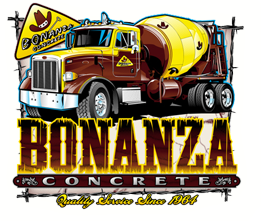
Good Concrete Practices for Flatwork
Concrete is an engineered product. When treated with respect and knowledge, it will out perform and out last all other paving products. Here is a list of tips that will help ensure your satisfaction:- Soil beneath the slab should be firm and compacted. A granular base is recommended in poor soil areas.
- For most patios, walkways and slabs, the concrete should be a minimum of 4" thick. If it will be subjected to heavy loads, thicker concrete may be recommended. Check with your engineer.
- Wire welded fabric or other types of steel reinforcing are generally not needed or recommended for walksways, patios or driveways.
- Order the correct concrete for your application. The use of pea-gravel pump mix is not recommended for flatwork. If you are unsure, please consult with Bonanza Concrete staff.
- Do not place concrete during hot or windy weather. During the summer months, it is recommended that concrete be placed late in the day or even at night to take advantage of cooling.
- Do not over work the concrete!!! After concrete is placed, smooth it out with a bullfloat, then wait. Do not start any finishing procedures while bleed water is present. Wait for the water sheen to disappear.
- Control joints are nice looking, pre-planned cracks. Control joints should be a minimum of 1/4 the thickness of the slab in depth. Saw cuts the day after the concrete is placed are too late. Saw cuts should be completed in the first 12 hours.
- Control joint spacing will be dependent upon the type of concrete used. When in doubt, check with Bonanza Concrete. Keep in mind, more joints equal fewer cracks.
- Cure, cure, cure! Curing concrete is the final and most overlooked finishing procedure. The easiest way to cure is with a spray on curing compound available from Bonanza Concrete. Do not wet the concrete with a garden hose and allow it to dry between wettings.
- Do not drive on a freshly poured driveway for a minimum of 7 days. The longer you can wait, the better!
 |
 |

